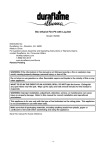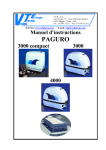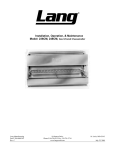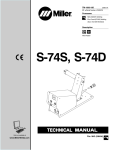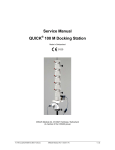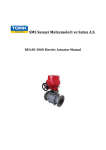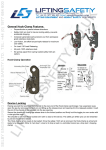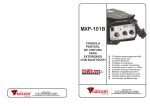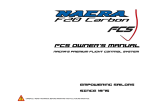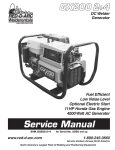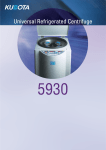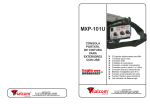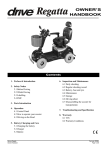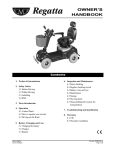Download E300 3+2 Service Manual - Red-D
Transcript
E300 3+2 Electric Welder Service Manual Stick/Mig Capability Welding Excellence Modular Construction Environment Protected 2,000 Watt AC Power for Tools SVM_E300 3+2 SAFETY Arc Welding Safety Precautions PROTECT YOURSELF AND OTHERS FROM POSSIBLE SERIOUS INJURY OR DEATH. READ AND UNDERSTAND BOTH THE SPECIFIC INFORMATION GIVEN IN THE OPERATING MANUAL FOR THE WELDER AND/OR OTHER EQUIPMENT TO BE USED AS WELL AS THE FOLLOWING GENERAL INFORMATION. 1. HAVE ALL INSTALLATION, OPERATION, MAINTENANCE AND REPAIR WORK performed only by qualified people. 2. ELECTRIC SHOCK can kill. Protect yourself from possible dangerous electrical shock: a. The electrode and work (or ground) circuits are electrically "hot" when the welder is on. Never permit contact between "hot" parts of the circuits and bare skin or wet clothing. Wear dry, hole-free gloves to insulate hands. b. Always insulate yourself from the work and ground by using dry insulation. When welding in damp locations, on metal floors, gratings or scaffolds, and when in positions such as sitting or lying, make certain the insulation is large enough to cover your full area of physical contact with work and ground. Do not weld in locations near chlorinated hydrocarbon vapours coming from degreasing, cleaning or spraying operations. The heat and rays of the arc can react with solvent vapours to form phosgene, a highly toxic gas, and other irritating products. c. Shielding gases used for arc welding can displace air and cause injury or death. Always use enough ventilation, especially in confined areas, to insure breathing air is safe. d. Read and understand the manufacturer's instructions for this equipment and the consumables to be used, including the material safety data sheet (MSDS) and follow your employer's safety practices. e. Also see item 9b. 4. ARC RAYS can injure eyes and burn skin. a. Use a shield with the proper filter and cover plates to protect your eyes from sparks and the rays of the arc when welding or observing open arc welding. Headshield and filter lens should conform to ANSI Z87. 1 standards. c. Always be sure the work cable makes a good electrical connection with the metal being welded. The connection should be as close as possible to the area being welded. d. Ground the work or metal to be welded to a good electrical ground. b. Use suitable clothing made from durable, flame-resistant material to protect your skin and that of your helpers from the arc rays. Maintain the electrode holder, work clamp, welding cable and welding machine in good, safe operating condition. c. Protect other nearby personnel with suitable nonflammable screening and/or warn them not to watch the arc nor expose themselves to the arc rays or to hot spatter or metal. e. f. Never dip the electrode in water for cooling. g. Never simultaneously touch electrically "hot" parts of electrode holders connected to two welders because voltage between the two can be the total of the open circuit voltage of both welders. h. If using the welder as a power source for mechanized welding, the above precautions also apply for the automatic electrode, electrode reel, welding head, nozzle or semiautomatic welding gun. i. When working above floor level, protect yourself from a fall should you get a shock. j. Also see Items 6c and 8. 3. FUMES AND GASES can be dangerous to your health. a. Welding may produce fumes and gases hazardous to health. Avoid breathing these fumes and gases. When welding, keep your head out of the fume. Use enough ventilation and/or exhaust at the arc to keep fumes and gases away from the breathing zone. When welding on galvanized, lead or cadmium plated steel and other metals which produce toxic fumes, even greater care must be taken. 2 b. 5. FIRE OR EXPLOSION can cause death or property damage. a. Remove fire hazards well away from the area. If this is not possible cover them to prevent the welding sparks from starting a fire. Remember that welding sparks and hot materials from welding can easily go through small cracks and openings to adjacent areas. Have a fire extinguisher readily available. b. Where compressed gases are to be used at the job site, special precautions should be used to prevent hazardous situations. Refer to "Safety in Welding and Cutting" (ANSI Standard 249.1) and the operating information for the equipment being used. c. When not welding, make certain no part of the electrode circuit is touching the work or ground. Accidental contact can cause overheating and create a fire hazard. d. Do not heat, cut or weld tanks, drums or containers until the proper steps have been taken to insure that such procedures will not cause flammable or toxic vapours from substances inside. They can cause an explosion even though they have been "cleaned." For information purchase "Recommended Safe Practices for the Preparation for Welding and Cutting of Containers and Piping That Have Held Hazardous Substances.", SAFETY Highway, Arlington, VA 22202. AWS F4.1-80 from the American Welding Society. e. Vent hollow castings or containers before heating, cutting or welding. They may explode. f. Also see items 6c and 9c. 6. For Welding in General. a. Droplets of molten slag and metal are thrown or fall from the welding arc. Protect yourself with oil free protective garments such as leather gloves, heavy shirt, cuffless trousers, high shoes and a cap over your hair. Wear ear plugs when welding out of position or in confined places. Always wear safety glasses when in a welding area. Use glasses with side shields when near slag chipping operations. b. c. Keep all equipment safety guards, covers and devices in position and in good repair. Keep hands, hair, clothing and tools away from V-belts, gears, fans and all other moving parts when starting, operating or repairing equipment. Be sure the work cable is connected to the work as close to the welding area as practical. Work cables connected to the building framework or other locations some distance from the welding area increase the possibility of the welding current passing through lifting chains, crane cables or other alternate circuits. This can create fire hazards or overheat lifting chains or cables until they fail. 7. For Gas-Shielded Arc Welding. a. Use only compressed gas cylinders containing the correct shielding gas for the process used and properly operating regulators designed for the gas and pressure used. All hoses, fittings, etc. should be suitable for the application and maintained in good condition. b. c. Always keeps cylinders in an upright position securely chained to an undercarriage or fixed support. Cylinders should be located: • Away from areas where they may be struck or subjected to physical damage. • A safe distance from arc welding or cutting operations and any other source of heat, sparks, or flame. d. Never allow the electrode, electrode holder, or any other electrically "hot" parts to touch a cylinder. e. Keep your head and face away from the cylinder valve outlet when opening the cylinder valve. f. Valve protection caps should always be in place and handtight except when the cylinder is in use or connected for use. g. Read and follow the instructions on compressed gas cylinders, associated equipment, and CGA publication P-1 "Precautions for Safe Handling of Compressed Gases in Cylinders" available from the Compressed Gas Association, 1235 Jefferson Davis 8. For Electrically Powered Equipment. a. Turn off input power using the disconnect switch at the fuse box before working on the equipment. b. Make the electrical installation in accordance with the National Electrical Code, all local codes and the manufacturer's recommendations. c. Properly ground the equipment in accordance with the National Electrical Code and the manufacturer's recommendations. 9. For Engine Powered Equipment. a. Turn the engine off before troubleshooting and maintenance work unless the maintenance work requires it to be running. b. Operate the internal combustion engines in open, well ventilated areas or vent the engine exhaust fumes outdoors. c. Do not add the fuel near an open flame, welding arc or when the engine is running. Stop the engine and, if possible, allow it to cool when refuelling to prevent spilled fuel from vaporizing on contact with hot engine parts and igniting. Do not spill fuel when filling tank. If fuel is spilled, wipe it up and do not start engine until fumes have been eliminated. d. In some cases it may be necessary to remove safety guards to perform required maintenance. Remove guards only when necessary and replace them when the maintenance requiring their removal is complete. Always use the greatest care when working near moving parts. e. Do not put your hands near the engine fan. Do not attempt to override the governor or idler by pushing on the throttle control rods while the engine is running. f. To prevent accidentally starting gasoline engines while turning the engine or welding generator during maintenance work, disconnect the spark plug wires, distributor cap or magneto wire as appropriate. g. To avoid scalding, do not remove the radiator pressure cap when the engine is hot. For more detailed information it is strongly recommended that you purchase a copy of "Safety in Welding & Cutting - ANSI Standard 249.1" from the American Welding Society, P.O. Box 351040 Miami, Florida 33135. 3 OPERATION OPERATION RATED OUTPUT DC For best operating characteristics and longest unit life, take care in selecting an installation site. Avoid locations exposed to high humidity, dust, high ambient temperature or corrosive fumes. Make sure that the ventilator openings are not obstructed. Amperes Volts Duty cycle 250 30 60% • Connect welding machine to input voltage. • Set INPUT CONTACTOR CONTROL ON/OFF SWITCH to ON (UP) position. • For LOCAL control, set the CURRENT CONTROL LOCAL/ REMOTE SWITCH to local (OFF) position. Adjust the welding current by the CURRENT CONTROL potentiometer located on the front panel. • For REMOTE control, set the above switch to remote (ON) position. Adjust the welding current by the potentiometer located in the remote control. For this mode of operation it will be necessary to use a Remote Control Pendant plugged into the REMOTE CONTROL RECEPTACLE. • THE ARC FORCE CONTROL potentiometer varies the dynamic slope of the volt-amp curves. It essentially charges the short-circuit (arc) current and produces an increase of amperage when the arc is shortened. Strong arc force is best suited for use with 6010 electrodes where there is a tendency for sticking, especially for down hand welding. MAINTENANCE • Lubrication The fan motor is permanently lubricated and will never need oil or grease. No other points require lubrication. • Cleaning For uninterrupted satisfactory service from this welding machine, it is necessary to keep the machine clean, dry and well ventilated. At lease every two months or more often as necessary,wipe and blow out all dirt from the machine's internal components with air pressure of not over 25psi. Be sure to wipe the fan blades clean. TECHNICAL DATA DIMENSIONS (LxWxH) NET WEIGHT DIMENSIONS ( in frame) NET WEIGHT (in frame) CSA APPROVED 4 680 x 405 x 530 mm 26.8 x15.9 x20.9 in 117kg / 258 lbs 775 x 535 x 560 mm 30.5 x 21 x 22 in 130kg / 285 lbs WELDING VOLTAGE AND CURRENT RANGE Minimum current at 20Volt Maximum current at 34Volt 20A 350A INPUT 3 PHASE 60Hz - AT RATED LOAD 480V - AMPS - OPT 21 600V - AMPS - OPT 17 PRIMARY KW 1l OPERATION TABLE 2 RECOMMENDED COPPER CABLE SIZES AT 60% DUTY CYCLE Cable Sizes for Combined Length of Electrode Plus Work Cable Machine Size in Amps Up to 200 ft. 200 to 250 ft. 250 1 1/0 CONTROL OF WELDING CURRENT There is one continuous current control which gives you complete adjustment of current from minimum to maximum. For local control make sure the remote control switch is in the "off' position. There is also the possibility of installing a remote control. To control at a distance the remote control switch must be in the "on" position. There is also an Arc Force control which produces an increase of amperage when the arc length is shortened, such as in a tight groove or in pipe welding. This control provides more arc force and eliminates the tendency of snuffing out the arc. AUXILIARY POWER Your E300 3+2 is equipped with AC auxiliary power. The AC unit provides a Duplex 120Volt receptacle and 2KW of maximum output. The output circuit is protected with circuit breakers. Power tools should always be grounded to the welded frame unless they are protected by an approved system of double insulation. MAINTENANCE Have qualified personnel do the maintenance work. Turn the engine off before working inside the machine. In some cases it may be necessary to remove safety guards to perform required maintenance. Remove guards only when necessary and replace them when the maintenance requiring their removal is complete. Always use the greatest care when working near moving parts. Do not put your hands near the engine or generator fan. If a problem cannot be corrected by following the instructions, take the machine to the nearest RED-D-ARC location. GENERAL INSTRUCTIONS 1. Blow out the welder and controls with an air hose at least once every two months. In particularly dirty locations, this cleaning may be necessary once a week. Use low pressure air to avoid driving dirt into the insulation. WARNING: Uncovered rotating equipment can be dangerous. Use care so your hands, hair, clothing or tools do not catch in the rotating parts. 5 CONTROL PANEL CONTROL PANEL FEATURES FRONT REAR 21 - Voltage change cover 22 - Supply cable input 23 - Grounding screw 1 - On/Off Switch/Breaker 30 AMP 2 - Ground fault protector 3 - On light 4 - Stick/Tig mode select switch (optional) 5 - Remote current switch: Switch must be "off" when using machine with no remote control, "ON" when using with remote control. 6 - Welding current control: Use to adjust amperage desired. 7 - Remote current control receptacle 8 - "CC-CV" mode select switch: CC for all Stick and Tig applications CV for most semi automatic Mig applications 9 - Arc force control: To use arc force turn switch to "ON" position. Arc force is used mostly when using 6010, 7010 type electrodes, especially for down hand. By using more arc force it makes the arc more forceful and prevents sticking. When a smoother arc is desired , use less arc force. 10 - Arc force on/off switch 11 - Hot start on/off switch : When the switch is on, a boost of current is applied for a very short time when the arc is struck. This is used in applications when arc starting is difficult. Do not use for Tig applications when soft start is desired. 12 - Positive electrode terminal 13 - Negative"MIG" terminal - has the least inductance and is recommended for MIG welding and arc air. 14 - Negative "stick" terminal - has the most inductance and is recommended for Stick and DC Tig welding. 15 - 15Amp circuit breaker 16 - 120 V single phase outlet 17 - I0Amp fuse for relay 120V 18 - lOAmp fuse for fan motor 19- Terminal board for wire feeder connections 20 - Serial number 6 TROUBLESHOOTING WARNING: • Have qualified personnel do the troubleshooting work. Turn the engine off before working inside the machine. In some cases it may be necessary to remove safety guards to perform required maintenance. Remove guards only when necessary and replace them when the maintenance requiring their removal is complete. Always use the greatest care when working near moving parts. • Do not put your hands near the engine fan. If a problem cannot be corrected by following the instructions, take the machine-to the nearest Red-D-Arc Location. TROUBLE CAUSE WHAT TO DO 1. Welder does not start Note: It is normal for the Fan not to run when machine is cold. No input power. Check power switch. Check lines voltage. Check power supply and connections. 2. Welder has not output. Remote control switch is in ‘ON’ position with no remote OCV=OV. Put remote switch in ‘OFF’ position. 3. Welder has abnormal arc. Defective SCR. Check OCV. If low check for defective SCRs. Also check all connections. Defective PC board. Check OCV. If low check for defective PC board. Also check all connections. 7 ASSEMBLY MISCELLANEOUS ASSEMBLY (SERIAL #s 0880 AND ABOVE) 8 ASSEMBLY MISC. ASSEMBLY PARTS LIST (SERIAL #s 0880 AND ABOVE) ITEM 1 2 3 4 5 6 7 8 9 10 11 12 13 14 15 16 17 18 19 20 21 22 23 24 25 26 27 28 29 30 31 32 33 34 35 36 37 38 39 40 41 42 43 44 45 46 47 48 49 PART NAME & DESCRIPTION Transformer assembly Over load Thermostat 132 degrees C Transformer Support Insulator Terminal Board Over load 63 degrees C Bracket Front panel Reactor Resistor 100 Ohm Rod Frame Assembly Base rails Louvers Circuit breaker 15 A Base plate Fan Fan cover Capacitor 4uF Circuit breaker 10 A Plate Side Bracket Heatsink Lower Bracket SCR diode IR 171RC40 Inside Bracket Zenamic Insulator Shunt Control panel frame assembly Relay Electronic panel GS9109b/c CC-CV Front plate Aluminum front name plate Circuit breaker 30 A Switch Potentiometer 10K Knob Lifting support bracket Stainless Steel Cover Voltage change cover Ground fault protector 25A Rubber protection cover On light Connection Plate Plate Inductor Rod Lifting Hook NO. REQ'D 1 1 1 13 1 1 1 1 1 1 1 1 2 3 1 1 1 1 1 2 1 2 4 1 6 2 6 3 1 1 1 1 1 1 1 4 2 2 1 1 1 1 1 1 3 1 1 8 1 PART NO. 15.077 14.277 14.886 11.707 17.516 14.285 16.967 16.968 16.648 12.776 12.777 16.969 15.081 15.082 13.640 17.504 16.080 14.878 363 13.728 17.505 15.086 14.752 15.083 905 14.754 12.736 954 14.899 14.893 14.765 16.970 14.895 17.823 15.084 910 12.993 14.293 15.085 14.901 16.972 356 13.410 11.221 15.419 17.506 14.993 622 16.973 9 ASSEMBLY MISC. ASSEMBLY PARTS LIST CONTINUED (SERIAL #s 0880 AND ABOVE) ITEM 50 51 52 53 54 55 56 57 58 59 60 61 62 64 65 66 10 PART NAME & DESCRIPTION CC-CV / Tig-Stick mode select switch (Optional lift arc) Electronic panel lift arc GS9414 (Optional lift arc) Capacitor 40uF 450V Tie rod Nut Circuit breaker support Left heatsink Right heatsink Washer Rubber protection cover Plate Output connector plate Female Euro connector Overload Thermostat 100 degrees C Plate Grounding screw NO. REQ'D 2 1 1 6 6 1 1 1 3 3 1 1 3 1 1 1 PART NO. 13.152 17.629 17.094 17.507 17.508 16.305 17.509 17.510 14.270 14.658 17.824 17.512 836 17.513 17.514 17.515 WIRING DIAGRAMS PRIMARY WIRING DIAGRAM 11 WIRING DIAGRAMS WIRING DIAGRAM 12 WIRING DIAGRAMS WIRING DIAGRAM WITH OPTIONAL TIG PC BOARD 13













